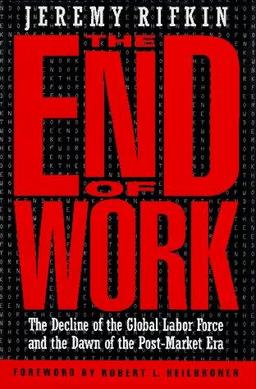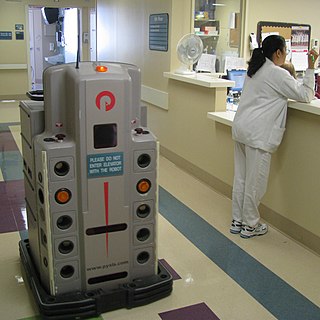Related Research Articles

A call centre or call center is a managed capability that can be centralised or remote that is used for receiving or transmitting a large volume of enquiries by telephone. An inbound call centre is operated by a company to administer incoming product or service support or information enquiries from consumers. Outbound call centres are usually operated for sales purposes such as telemarketing, for solicitation of charitable or political donations, debt collection, market research, emergency notifications, and urgent/critical needs blood banks. A contact centre is a further extension to call centres telephony based capabilities, administers centralised handling of individual communications, including letters, faxes, live support software, social media, instant message, and email.
An automated call distribution system, commonly known as automatic call distributor or automatic call dispatcher (ACD), is a telephony device that answers and distributes incoming calls to a specific group of terminals or agents within an organization. ACDs direct calls based on parameters that may include the caller's telephone number, the number they dialed, the time of day or a response to an automated voice prompt. Advanced ACD systems may use digital technologies such as computer telephony integration (CTI), computer-supported telecommunications applications (CSTA) or IVR as input to determine the route to a person or voice announcement that will serve the caller. Experts claim that "the invention of ACD technology made the concept of a call centre possible."
Interactive voice response (IVR) is a technology that allows telephone users to interact with a computer-operated telephone system through the use of voice and DTMF tones input with a keypad. In telephony, IVR allows customers to interact with a company's host system via a telephone keypad or by speech recognition, after which services can be inquired about through the IVR dialogue. IVR systems can respond with pre-recorded or dynamically generated audio to further direct users on how to proceed. IVR systems deployed in the network are sized to handle large call volumes and also used for outbound calling as IVR systems are more intelligent than many predictive dialer systems.

Automation describes a wide range of technologies that reduce human intervention in processes, mainly by predetermining decision criteria, subprocess relationships, and related actions, as well as embodying those predeterminations in machines. Automation has been achieved by various means including mechanical, hydraulic, pneumatic, electrical, electronic devices, and computers, usually in combination. Complicated systems, such as modern factories, airplanes, and ships typically use combinations of all of these techniques. The benefit of automation includes labor savings, reducing waste, savings in electricity costs, savings in material costs, and improvements to quality, accuracy, and precision.
A predictive dialer dials a list of telephone numbers and connects answered dials to people making calls, often referred to as agents. Predictive dialers use statistical algorithms to minimize the time that agents spend waiting between conversations, while minimizing the occurrence of someone answering when no agent is available.
Telepresence refers to a set of technologies which allow a person to feel as if they were present, to give the appearance or effect of being present via telerobotics, at a place other than their true location.
A dialer or dialler is an electronic device that is connected to a telephone line to monitor the dialed numbers and alter them to seamlessly provide services that otherwise require lengthy National or International access codes to be dialed. A dialer automatically inserts and modifies the numbers depending on the time of day, country or area code dialed, allowing the user to subscribe to the service providers who offer the best rates. For example, a dialer could be programmed to use one service provider for international calls and another for cellular calls. This process is known as prefix insertion or least cost routing. A line powered dialer does not need any external power but instead takes the power it needs from the telephone line.

A collaboration tool helps people to collaborate. The purpose of a collaboration tool is to support a group of two or more individuals to accomplish a common goal or objective. Collaboration tools can be either of a non-technological nature such as paper, flipcharts, post-it notes or whiteboards. They can also include software tools and applications such as collaborative software.

Emerging technologies are technologies whose development, practical applications, or both are still largely unrealized. These technologies are generally new but also include older technologies finding new applications. Emerging technologies are often perceived as capable of changing the status quo.
A soundboard is a computer program, Web application, or device, formerly created in Adobe Flash, that catalogues and plays many audio clips. Soundboards are self-contained, requiring no outside media player. In recent years soundboards have been made available in the form of mobile apps available on iPhone App Store and Google Play. Since Adobe and web browser developers deprecated support for Flash, HTML5-based soundboards have gained popularity in recent years.

In computing, multi-touch is technology that enables a surface to recognize the presence of more than one point of contact with the surface at the same time. The origins of multitouch began at CERN, MIT, University of Toronto, Carnegie Mellon University and Bell Labs in the 1970s. CERN started using multi-touch screens as early as 1976 for the controls of the Super Proton Synchrotron. Capacitive multi-touch displays were popularized by Apple's iPhone in 2007. Multi-touch may be used to implement additional functionality, such as pinch to zoom or to activate certain subroutines attached to predefined gestures using gesture recognition.

The End of Work: The Decline of the Global Labor Force and the Dawn of the Post-Market Era is a non-fiction book by American economist Jeremy Rifkin, published in 1995 by Putnam Publishing Group.
Unified communications (UC) is a business and marketing concept describing the integration of enterprise communication services such as instant messaging (chat), presence information, voice, mobility features, audio, web & video conferencing, fixed-mobile convergence (FMC), desktop sharing, data sharing, call control and speech recognition with non-real-time communication services such as unified messaging. UC is not necessarily a single product, but a set of products that provides a consistent unified user interface and user experience across multiple devices and media types.
A virtual assistant (VA) is a software agent that can perform a range of tasks or services for a user based on user input such as commands or questions, including verbal ones. Such technologies often incorporate chatbot capabilities to simulate human conversation, such as via online chat, to facilitate interaction with their users. The interaction may be via text, graphical interface, or voice - as some virtual assistants are able to interpret human speech and respond via synthesized voices.

Technological unemployment is the loss of jobs caused by technological change. It is a key type of structural unemployment. Technological change typically includes the introduction of labour-saving "mechanical-muscle" machines or more efficient "mechanical-mind" processes (automation), and humans' role in these processes are minimized. Just as horses were gradually made obsolete as transport by the automobile and as labourer by the tractor, humans' jobs have also been affected throughout modern history. Historical examples include artisan weavers reduced to poverty after the introduction of mechanized looms. During World War II, Alan Turing's bombe machine compressed and decoded thousands of man-years worth of encrypted data in a matter of hours. A contemporary example of technological unemployment is the displacement of retail cashiers by self-service tills and cashierless stores.
Agent-assisted automation is a type of call center technology that automates elements of what the call center agent 1) does with his/her desktop tools and/or 2) says to customers during the call using pre-recorded audio. It is a relatively new category of call center technology that shows promise in improving call center productivity and compliance.
An automatic dialer is an electronic device or software program that automatically dials telephone numbers. Once the call has been answered, the autodialer either plays a recorded message or connects the call to a live person.
Unified communications (UC) management is essentially the management of unified communications; it refers to the systems used by enterprise organizations to automate their enterprise communications services and the voice network infrastructure that those services run over.
Robotic process automation (RPA) is a form of business process automation that is based on software robots (bots) or artificial intelligence (AI) agents. It is sometimes referred to as software robotics.
AOMedia Video 1 (AV1) is an open, royalty-free video coding format initially designed for video transmissions over the Internet. It was developed as a successor to VP9 by the Alliance for Open Media (AOMedia), a consortium founded in 2015 that includes semiconductor firms, video on demand providers, video content producers, software development companies and web browser vendors. The AV1 bitstream specification includes a reference video codec. In 2018, Facebook conducted testing that approximated real-world conditions, and the AV1 reference encoder achieved 34%, 46.2%, and 50.3% higher data compression than libvpx-vp9, x264 High profile, and x264 Main profile respectively.
References
- ↑ Ryskamp, Rix. "Patent Number 7,734,029". United States Patent Office.
- ↑ Cisco Systems. "Call Progress Analysis" (PDF). Cisco.
- 1 2 "Call Comparison Video" (PDF). YouTube.
- ↑ "How Natural Predictive Works Video". YouTube.
- ↑ "Natural Contact Website". Transcend Products.